Emergency Safety Interventions
Emergency Safety Intervention - (ESI)
Parent Information
If an emergency safety intervention occurs, parents are strongly encouraged to schedule a meeting to: 1) discuss the incident and 2) discuss prevention of future use of emergency safety interventions. The district contact listed below is available to assist in scheduling this meeting. This meeting will be scheduled no later than ten (10) school days from when the parent makes the request unless the parent cannot meet within that time frame.
USD 307 Ell-Saline
www.ellsaline.org
Brian Rowley
785-225-6813
browley@ellsaline.org
Documents Included in this Packet
District Emergency Safety Intervention Policy
Including dispute resolution process
Standards for the Use of Emergency Safety Interventions
A Family Guide to the Use of Emergency Safety Interventions and Parental Rights: Seclusion and Restraint in Kansas
Local Dispute Resolution Guide for Parents
State Board Administrative Review Process
State Administrative Review Guide for Parents
State and Community Resources
District Emergency Safety Intervention Policy
Including dispute resolution process
GAAF Emergency Safety Interventions (See JRB, JQ, JQA, and KN)
The board of education is committed to limiting the use of Emergency Safety Intervention (“ESI”), such as seclusion and restraint, with all students. The board of education encourages all employees to utilize other behavioral management tools, including prevention techniques, de-escalation techniques, and positive behavioral intervention strategies.
The policy shall be made available on the district website with links to the policy available on any individual school pages. In addition, this policy shall be included in at least one of the following: each school’s code of conduct, school safety plan, or student handbook. Notice of the online availability of this policy shall be provided to parents during enrollment each year.
Definitions “Campus police officer” means a school security officer designated by the board of education of any school district pursuant to K.S.A. 72-8222, and amendments thereto.
“Chemical Restraint” means the use of medication to control a student’s violent physical behavior or restrict a student’s freedom of movement.
“Emergency Safety Intervention” is the use of seclusion or physical restraint.
“Incident” means each occurrence of the use of an emergency safety intervention.
“Law enforcement officer” and “police officer” mean a full-time or part-time salaried officer or employee of the state, a county, or a city, whose duties include the prevention or detection of crime and the enforcement of criminal or traffic law of this state or any Kansas municipality. This term includes a campus police officer.
“Legitimate law enforcement purpose” means a goal within the lawful authority of an officer that is to be achieved through methods or conduct condoned by the officer’s appointing authority.
“Mechanical Restraint” means any device or object used to limit a student’s movement.
“Parent” means: (1) a natural parent; (2) an adoptive parent; (3) a person acting as a parent as defined in K.S.A. 72-1046(d)(2), and amendments thereto; (4) a legal guardian; (5) an education advocate for a student with an exceptionality; or (6) a foster parent, unless the student is a child with an exceptionality; or (7) a student who has reached the age of majority or is an emancipated minor.
“Physical Escort” means the temporary touching or holding the hand, wrist, arm, shoulder, or back of a student who is acting out for the purpose of inducing the student to walk to a safe location.
“Physical Restraint” means bodily force used to substantially limit a student’s movement, except that consensual, solicited or unintentional contact and contact to provide comfort, assistance, or instruction shall not be deemed to be physical restraint.
“School resource officer” means a law enforcement officer or police officer employed by a local law enforcement agency who is assigned to a district through an agreement between the local law enforcement agency and the district.
“School security officer” means a person who is employed by a board of education of any school district for the purpose of aiding and supplementing state and local law enforcement agencies in which the school district is located, but is not a law enforcement officer or police officer.
“Seclusion” means placement of a student in a location where all of the following conditions are met: (1) the student is placed in an enclosed area by school personnel; (2) the student is purposefully isolated from adults and peers; and (3) the student is prevented from leaving, or reasonably believes that he or she will be prevented from leaving, the enclosed area.
“Time-out” means a behavioral intervention in which a student is temporarily removed from a learning activity without being secluded.
Prohibited Types of Restraint
All staff members are prohibited from engaging in the following actions with a student:
- Using face-down (prone) physical restraint;
- Using face-up (supine) physical restraint;
- Using physical restraint that obstructs the student’s airway;
- Using physical restraint that impacts a student’s primary mode of communication;
- Using chemical restraint, except as prescribed treatments for a student’s medical or physical condition by a person appropriately licensed to issue such treatments; and
- Use of mechanical restraint, except:
- Protective or stabilizing devices required by law or used in accordance with an order person appropriately licensed to issue the order for the device;
- Any device used by a certified law enforcement officer
sto carry out law enforcement duties; or - Seatbelts and other safety equipment when used to secure students during transportation.
Use of Emergency Safety Interventions
ESI shall be used only when a student presents a reasonable and immediate danger of physical harm to such student or others with the present ability to effect such physical harm. Less restrictive alternatives to ESI, such as positive behavior interventions support, shall be deemed inappropriate or ineffective under the circumstances by the school employee witnessing the student’s behavior prior to the use of any ESI. The use of ESI shall cease as soon as the immediate danger of physical harm ceases to exist. Violent action that is destructive of property may necessitate the use of an ESI. Use of an ESI for purposed of discipline, punishment or for the convenience of a school employee shall not meet the standard of immediate danger of physical harm.
ESI Restrictions
A student shall not be subjected to ESI if the student is known to have a medical condition that could put the student in mental or physical danger as a result of ESI. The existence of such medical condition must be indicated in a written statement from the student’s licensed health care provider, a copy of which has been provided to the school and placed in the student’s file.
Such written statement shall include an explanation of the student’s diagnosis, a list of any reasons why ESI would put the student in mental or physical danger, and any suggested alternatives to ESI. Notwithstanding the provisions of this subsection, a student may be subjected to ESI, if not subjecting the student to ESI would result in significant physical harm to the student or others.
Use of Seclusion
When a student is placed in seclusion, a school employee shall be able to see and hear the student at all times.
All seclusion rooms equipped with a locking door shall be designed to ensure that the lock automatically disengages when the school employee viewing the student walks away from the seclusion room or in case of emergency, such as fire or severe weather.
A seclusion room shall be a safe place with proportional and similar characteristics as other rooms where students frequent. Such room shall be free of any conditions that could be a danger to the student, well-ventilated and sufficiently lighted.
Training
All staff members shall be trained regarding the use of positive behavioral intervention strategies, de-escalation techniques, and prevention techniques. Such training shall be consistent with nationally recognized training programs on the use of ESI. The intensity of the training provided will depend upon the employee’s position. Administrators, licensed staff members, and other staff deemed most likely to need to restrain a student will be provided more intense training than classified staff who do not work directly with students in the classroom. District and building administration shall make the determination of the intensity of training required by each position.
Each school building shall maintain written or electronic documentation regarding the training that was provided and a list of participants, which shall be made available for inspection by the state board of education upon request.
Notification and Documentation
The principal or designee shall notify the parent the same day of an incident. The same-day notification requirement of this subsection shall be deemed satisfied if the school attempts at least two methods of contacting the parent. A parent may designate a preferred method of contact to receive the same-day notification. Also, a parent may agree, in writing, to receive only one same-day notification from the school for multiple incidents occurring on the same day.
Documentation of the ESI used shall be completed and provided to the student’s parents no later than the school day following the day of the incident. Such written documentation shall include: (A) The events leading up to the incident; (B) student behaviors that necessitated the ESI; (C) steps taken to transition the student back into the educational setting; (D) the date and time the incident occurred, the type of ESI used, the duration of the ESI, and the school
personnel who used or supervised the ESI; (E) space or an additional form for parents to provide feedback or comments to the school regarding the incident; (F) a statement that invites and strongly encourages parents to schedule a meeting to discuss the incident and how to prevent future incidents; and (G) email and phone information for the parent to contact the school to schedule the ESI meeting. Schools may
group incidents together when documenting the items in subparagraphs (A), (B) and (C) if the triggering issue necessitating the ESIs is the same.
The parent shall be provided the following information after the first and each subsequent incident during each school year: (1) a copy of this policy which indicates when ESI can be used; (2) a flyer on the parent’s rights; (3) information on the parent’s right to file a complaint through the local dispute resolution process (which is set forth in this policy) and the complaint process of the state board of education; and (4) information that will assist the parent in navigating the complaint process, including contact information for Families Together and the Disability Rights Center of Kansas. Upon the first occurrence of an incident of ESI, the foregoing information shall be provided in printed form or, upon the parent’s written request, by email. Upon the occurrence of a second or subsequent incident, the parent shall be provided with a full and direct website address containing such information.
Law Enforcement, School Resource, and Campus Security Officers
Campus police officers and school resource officers shall be exempt from the requirements of this policy when engaged in an activity that has a legitimate law enforcement purpose. School security officers shall not be exempt from the requirements of this policy.
If a school is aware that a law enforcement officer or school resource officer has used seclusion, physical restraint, or mechanical restraint on a student, the school shall notify the parent the same day using the parent’s preferred method of contact. A school shall not be required to provide written documentation to a parent, as set forth above, regarding law enforcement use of an emergency safety intervention, or report to the state department of education any law enforcement use of an emergency safety intervention. For purposes of this subsection mechanical restraint includes, but is not limited to, the use of handcuffs.
Documentation of ESI Incidents
Except as specified above with regard to law enforcement or school resource officer use of emergency safety interventions, each building shall maintain documentation any time ESI is used with a student. Such documentation must include all the following:
- Date and time of the ESI,
- Type of ESI,
- Length of time the ESI was used,
- School personnel who participated in or supervised the ESI
- Whether the student had an individualized education program at the time of the incident,
- Whether the student had a section 504 plan at the time of the incident, and
- Whether the student had a behavior intervention plan at the time of the incident.
All such documentation shall be provided to the building principal, who shall be responsible for providing copies of such documentation to the superintendent or the superintendent’s designee on at least a biannual basis. At least once per school year, each building principal or designee shall review the documentation of ESI incidents with appropriate staff members to consider the appropriateness of the use of ESI in those instances.
Reporting Data
District administration shall report ESI data to the state department of education as required.
Parent Right to Meeting on ESI Use
After each incident, a parent may request a meeting with the school to discuss and debrief the incident. A parent may request such meeting verbally, in writing, or by electronic means. A school shall hold a meeting requested under this subsection within 10 school days of the parent’s request. The focus of any such meeting shall be to discuss proactive ways to prevent the need for emergency safety interventions and to reduce incidents in the future.
For a student with an IEP or a Section 504 plan, such student’s IEP team or Section 504 plan team shall discuss the incident and consider the need to conduct a functional behavioral assessment, develop a behavior intervention plan, or amend the behavior intervention plan if already in existence.
For a student with a section 504 plan, such student’s section 504 plan team shall discuss and consider the need for a special education evaluation. For students who have an individualized education program and are placed in a private school by a parent, a meeting called under this subsection shall include the parent and the private school, who shall consider whether the parent should request an individualized education program team meeting. If the parent requests an individualized education program team meeting, the private school shall help facilitate such meeting.
For a student without an IEP or Section 504 plan, the school staff and the parent discuss the incident and consider the appropriateness of a referral for a special education evaluation, the need for a functional behavioral assessment, or the need for a behavior plan. Any such meeting shall include the student’s parent, a school administrator for the school the student attends, one of the student’s teachers, a school employee involved in the incident, and any other school employees designated by the school administrator as appropriate for such meeting.
The student who is the subject of such meetings shall be invited to attend the meeting at the discretion of the parent. The time for calling such a meeting may be extended beyond the 10-day limit if the parent of the student is unable to attend within that time period. Nothing in this section shall be construed to prohibit the development and implementation of a functional behavior assessment or a behavior intervention plan for any student if such student would benefit from such measures.
Local Dispute Resolution Process
If a parent believes that an emergency safety intervention has been used on the parent’s child in violation of state law or board policy, the parent may file a complaint as specified below.
The board of education encourages parents to attempt to resolve issues relating to the use of ESI informally with the building principal and/or the superintendent before filing a formal complaint with the board. Once an informal complaint is received, the administrator handling such complaint shall investigate such matter, as deemed appropriate by the administrator. In the event that the complaint is
resolved informally, the administrator must provide a written report of the informal resolution to the superintendent and the parents and retain a copy of the report at the school. The superintendent will share the informal resolution with the board of education and provide a copy to the state department of education.
If the issues are not resolved informally with the building principal and/or the superintendent, the parents may submit a formal written complaint to the board of education by providing a copy of the complaint to the clerk of the board and the superintendent within thirty (30) days after the parent is informed of the ESI.
Upon receipt of a formal written complaint, the board president shall assign an investigator to review the complaint and report findings to the board as a whole. Such investigator may be a board member, a school administrator selected by the board, or a board attorney. Such investigator shall be
informed of the obligation to maintain confidentiality of student records and shall report the findings of fact and recommended corrective action, if any, to the board in executive session.
Any such investigation must be completed within thirty (30) days of receipt of the formal written complaint by the board clerk or superintendent. On or before the 30th day after receipt of the written complaint, the board shall adopt written findings of fact and, if necessary, appropriate corrective action. A copy of the written report of findings of fact and any corrective action, if any, adopted by the board shall be provided to the parents, the school, and the state department of education and shall be mailed to the parents and state department within 30 days of the board’s sereceipt of the formal complaint.
If desired, a parent may file a complaint under the state board of education administrative review process within thirty (30) days from the date a final decision is issued pursuant to the local dispute resolution process.
Approved: July 2013; December 14, 2015; 4/10/17
Standards for the use of Emergency Safety Interventions
Emergency safety interventions law sets forth standards for the use of restraint and seclusion to ensure that all Kansas students and staff have a safe learning environment. The standards found in the emergency safety intervention statutes and regulations are required to be followed in all Kansas public school districts and accredited private schools.
An emergency safety intervention is the use of seclusion or physical restraint. The use of an emergency safety intervention shall cease as soon as the immediate danger of physical harm and violent action ceases to exist.
Before using an emergency safety intervention, a school employee witnessing the student’s behavior must have determined that less restrictive alternatives to emergency safety interventions, such as positive behavior interventions support, were inappropriate or ineffective under the circumstances.
An emergency safety intervention shall be used only when a student presents a reasonable and immediate danger of physical harm to such student or others with the present ability to effect such physical harm. Violent action that is destructive of property may necessitate the use of an emergency safety intervention if there is a reasonable and immediate danger of physical harm. An emergency safety intervention may not be used for purposes of discipline, punishment, or for the convenience of a school employee.
Physical restraint means bodily force used to substantially limit a student’s movement. Physical restraint is NOT:
- Consensual, solicited or unintentional contact and contact to provide comfort, assistance or instruction;
- physical escort;
- prescribed treatments for a student’s medical or psychiatric condition by a person appropriately licensed to issue these treatments;
- protective or stabilizing devices either ordered by an appropriately licensed professional or required by law;
- any device used by a law enforcement officer in carrying out law enforcement duties; and
- seatbelts and any other safety equipment when used to secure students during transportation.
Prohibited types of restraints:
- Prone, or face-down, physical restraint;
- supine, or face-up, physical restraint;
- any physical restraint that obstructs the airway of a student;
- any physical restraint that impacts a student’s primary mode of communication;
- chemical restraint (‘‘chemical restraint’’ means the use of medication to control a student’s violent physical behavior or restrict a student’s freedom of movement.); and
- mechanical restraint (‘‘mechanical restraint’’ means any device or object used to limit a student’s movement).
Seclusion means placement of a student in a location where:
- The student is placed in an enclosed area by school personnel;
- the student is purposefully isolated from adults and peers; and
- the student is prevented from leaving, or the student reasonably believes that such student will be prevented from leaving, the enclosed area.
An emergency safety intervention may not be used with a student if the student is known to have a medical condition that could put the student in mental or physical danger as a result of the use of an emergency safety intervention unless not using an emergency safety intervention would result in significant physical harm to the student or others. The medical condition must be indicated in a written statement from the student’s licensed health care provider, and a copy of which shall be provided to the school and placed in the student’s file.
When a student is placed in seclusion, a school employee shall be able to see and hear the student at all times.
If a seclusion room has a locking door it must be designed to ensure that the lock automatically disengages when the school employee viewing the student walks away from the seclusion room, or in cases of emergency, such as fire or severe weather.
A seclusion room must be a safe place. The room must have good ventilation and lighting, and be free of any condition that could be a danger to the student. The room must also be similar to other rooms where students frequent.
Seclusion is not time-out, which is a behavioral intervention in which a student is temporarily removed from a learning activity without being confined.
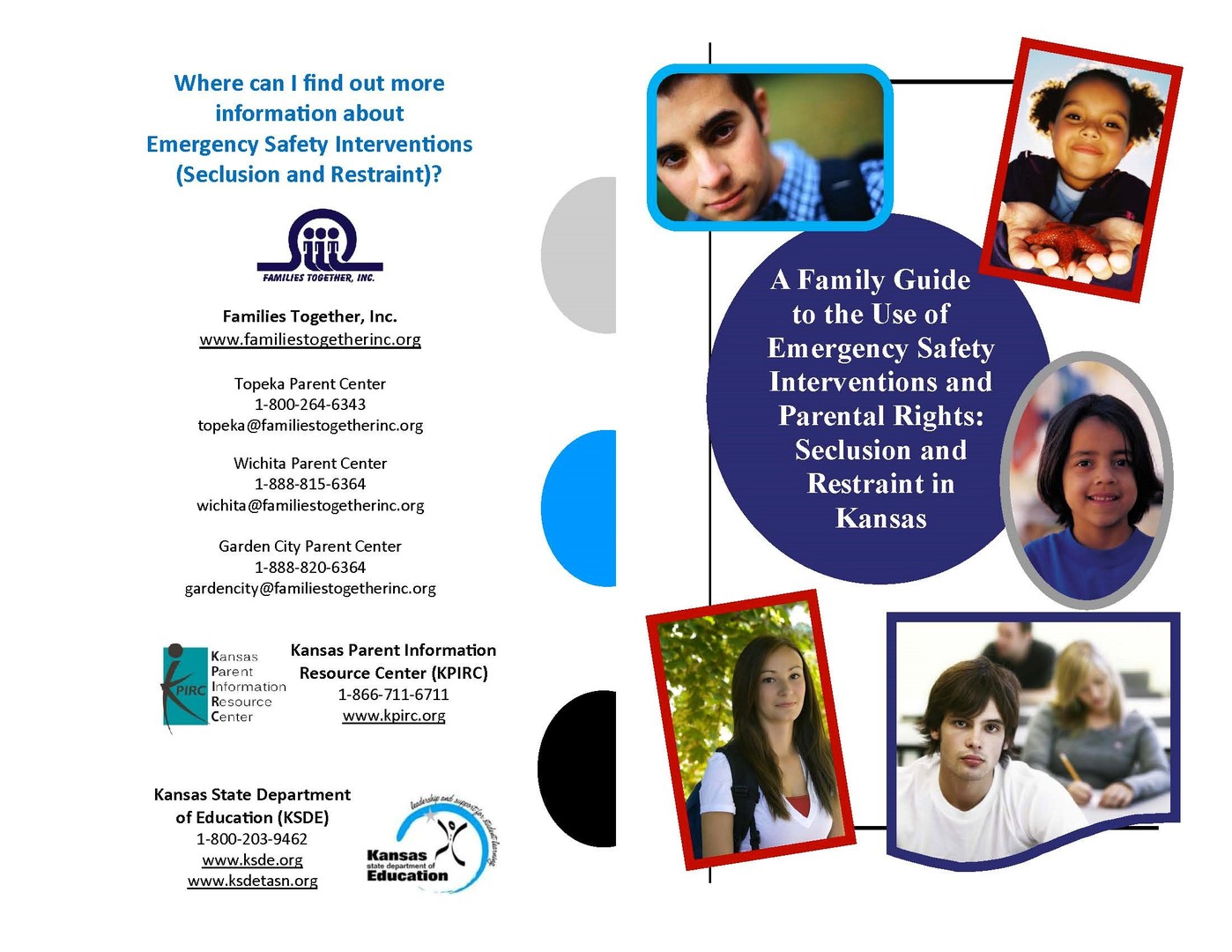

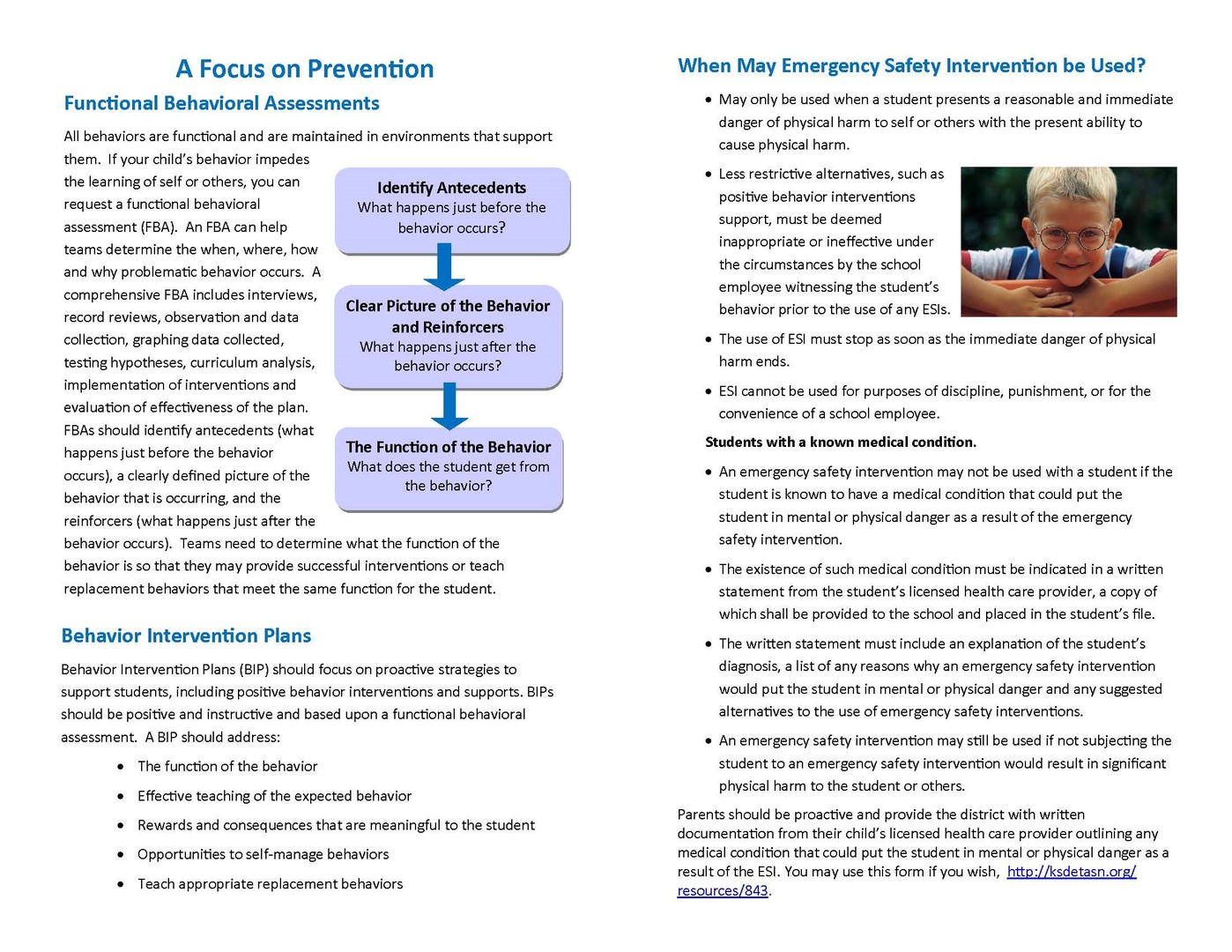
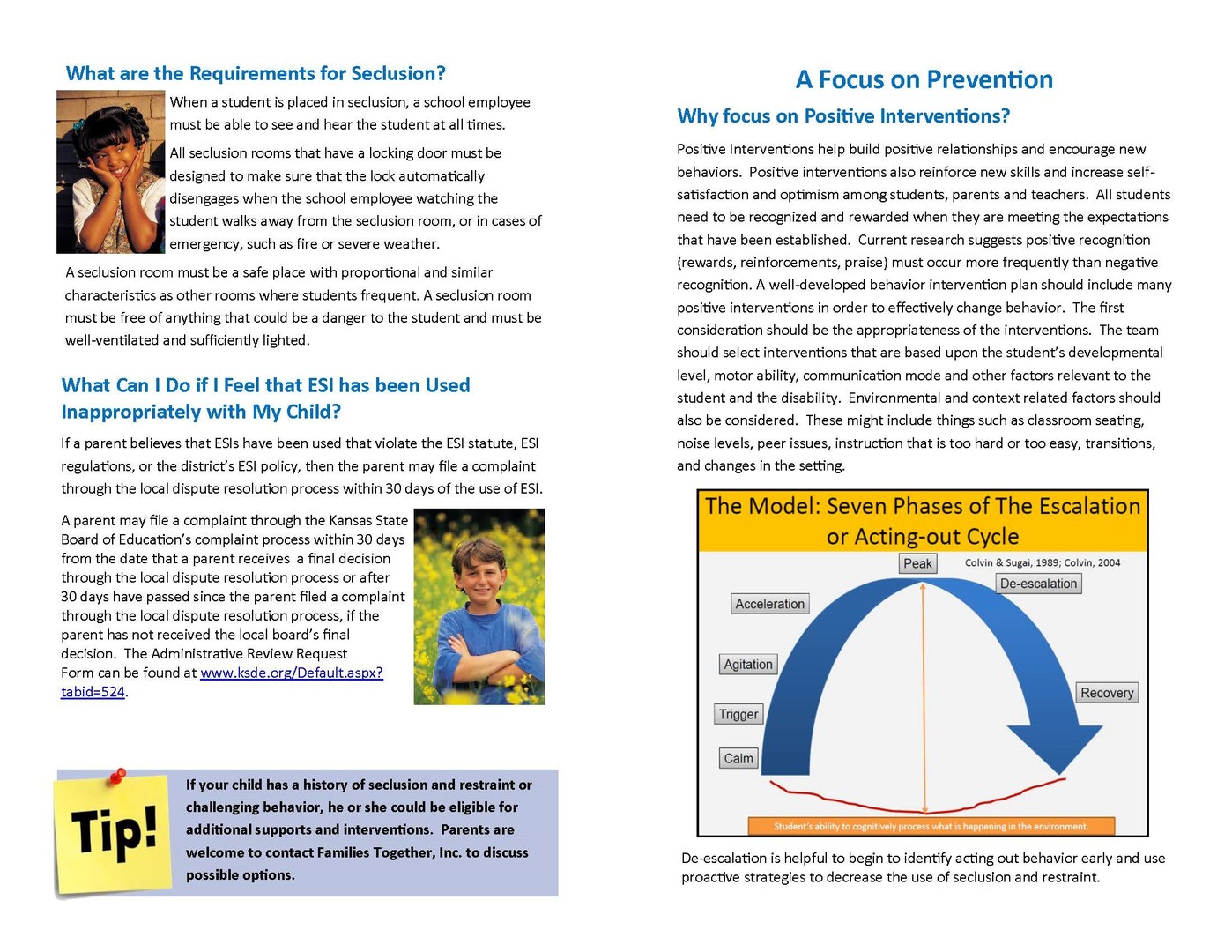

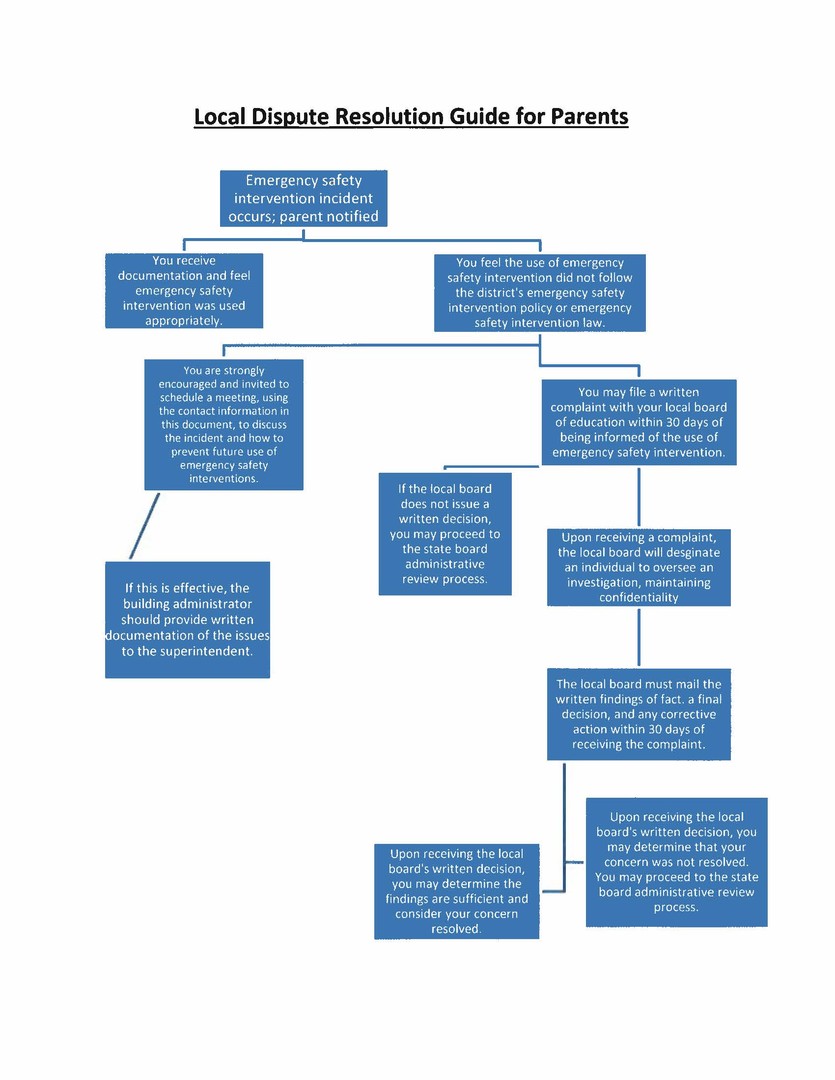
State Board Administrative Review Process
Refer to K.A.R. 91-42-5 for complete information. The following provides a summary of the regulations regarding an administrative review initiated with the Kansas State Board of Education (State Board).
- If a parent believes an emergency safety intervention was used in violation of K.S.A. 2017 Supp. 72‐6151 through 72-6158 or K.A.R. 91-42-1 through 91-42-7 and the parent filed a written complaint with their local board of education, then this parent may request an administrative review of the local board’s decision from the State Board.
- The request for administrative review must include the following information:
- Name of the student and contact information;
- Names and contact information for all involved parties (teachers, aides, administrators, and district staff), to the extent known;
- A detailed statement of the reason for requesting an administrative review;
- Any supporting facts and documentation; and
- A copy of the complaint filed with the local board, the local board’s final decision (if issued).
- The written request for administrative review must be typed or legibly written and signed by the parent.
- Relevant documents must be attached or, if unavailable, the documents must be referenced in the request for administrative review.
- Written consent to disclose any personally identifiable information from the student’s education records necessary to conduct an investigation
- The request for administrative review must include the following information:
- The request for administrative review must be filed with the Commissioner of Education within 30 days of the local board issuing its final decision OR within 60 days from the date the parent filed a complaint with the local board, if the local board did not issue a final decision. You may mail this request to the Kansas State Department of Education, Landon State Office Building, 900 SW Jackson Street, Office of General Counsel, Room 102, Topeka, Kansas 66612. KSDE has provided a form for you to use, if you wish, and you can find it on the Emergency Safety Interventions page of the KSDE website, www.ksde.org/Default.aspx?tabid=524.
- A Hearing Officer will be designated by the State Board. The Hearing Officer must send a copy of the request for administrative review to the local board.
- The Hearing Officer will consider the local board’s final decision and may initiate an investigation that could include:
- A discussion with the parent, during which additional information may be gathered;
- Contact with the local board or other district staff to allow the local board to respond to the request with information supporting its final decision; and
- An on-site investigation by Kansas State Department of Education staff.
- If new information is discovered that was not made available to both the parent and the local board during the dispute resolution process, the Hearing Officer may send the issue back to the local board.
- If sent back to the local board, the Hearing Officer’s case will be closed and the local board has 30 days to issue a written amended final decision.
- If the parent feels the local board’s amended final decision does not adequately address the issue, the parent may file a new request for administrative review with the commissioner by following the above process for requesting administrative review. This must be done within 30 days of the local board issuing its amended final decision. If the local board does not issue an amended final decision within 30 days, then the parent has 30 days from the date the Hearing Officer sent the issue back to the local board to file a request for administrative review with the commissioner.
- Within 60 days of receiving the request for administrative review, the Hearing Officer will, in writing, inform the parents, school administrator, district superintendent, local board clerk, and the state board of the results of the review. This time frame may be extended for good cause upon approval of the commissioner.
- The results of the administrative review will contain findings of fact, conclusions of law, and any suggested corrective actions. The Hearing Officer’s determination will include one of the following:
- The local board appropriately resolved the complaint.
- The local board should re-evaluate the complaint with suggested findings of fact.
- The Hearing Officer’s suggested corrective active is necessary to ensure that local board policies meet legal requirement
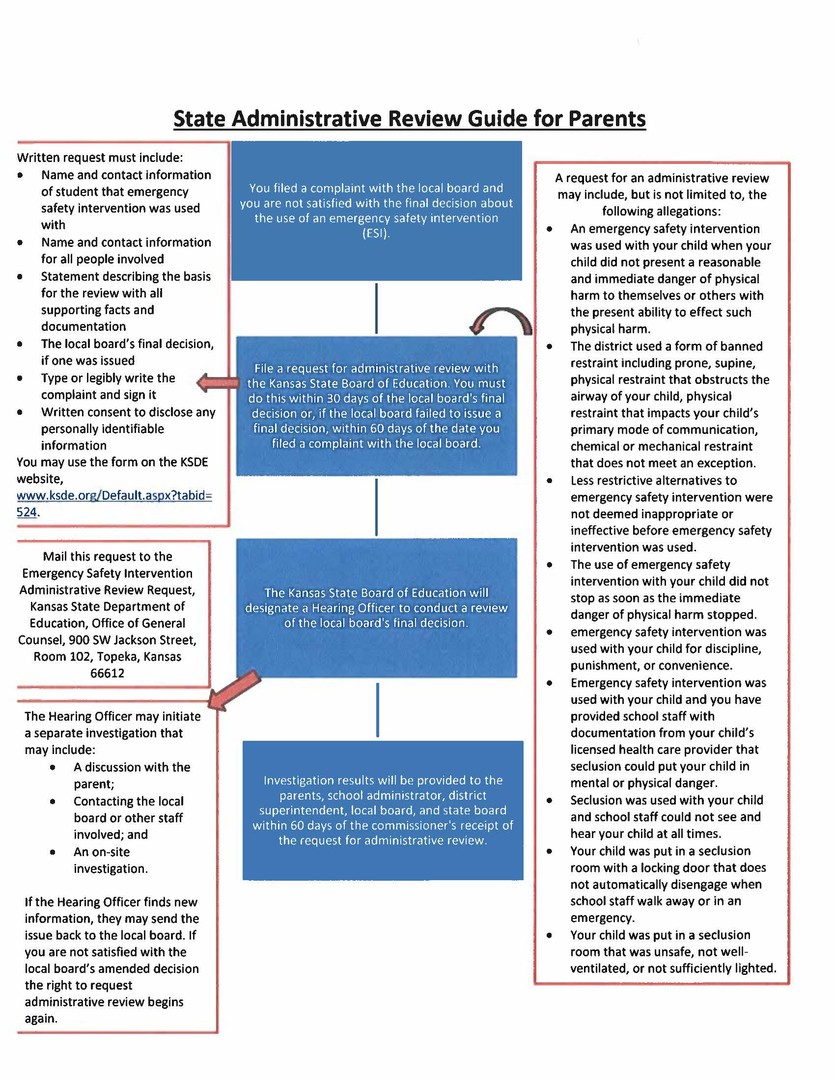
State and Community Resources
General Emergency Safety Intervention Information:
www.ksde.org/Default.aspx?tabid=524
Emergency Safety Intervention Questions:
Laura Jurgensen
Kansas State Department of Education
785-296-5522
Parent Training and Information Center:
Families Together
http://familiestogetherinc.org/
888-815-6364
Protection and Advocacy System:
Disability Rights Center of Kansas
877-776-1541 or 785-273-9661


